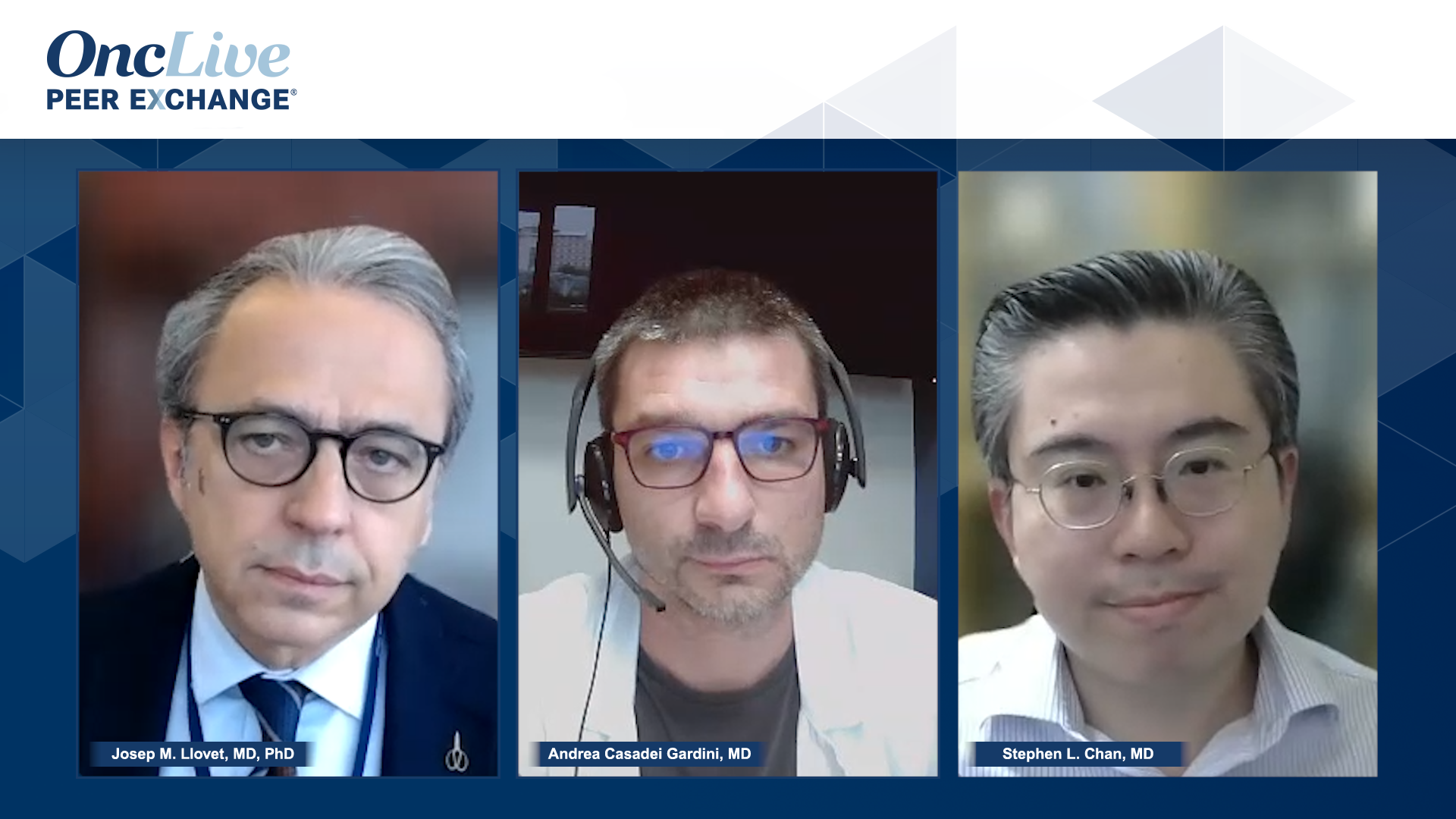- Advertise
- About OncLive
- Editorial Board
- MJH Life Sciences brands
- Contact Us
- Privacy
- Terms & Conditions
- Do Not Sell My Information
2 Clarke Drive
Suite 100
Cranbury, NJ 08512
© 2025 MJH Life Sciences™ and OncLive - Clinical Oncology News, Cancer Expert Insights. All rights reserved.
Treatment Options for Advanced HCC With Underlying NASH
A panel of experts in gastroenterology review the case of a 65-year-old man with advanced HCC associated with NASH and comment on treatment with TKIs and immunotherapy.
Josep M. Llovet, MD, PhD: We can now move to the third case, which is the HCC [hepatocellular carcinoma] treatment associated with NASH [nonalcoholic steatohepatitis]. We are aware that NASH HCC is increasing globally, particularly in the West and in the United States, where 40% of the population is obese. The No. 1 fastest-growing [etiology of HCC] is NASH, but hepatitis C is decreasing. That still is the No. 1 etiology of HCC in the US, but it is quickly decreasing because of antiviral therapies. Hepatitis B is very marginal, mostly in patients with Asian-American ancestry. Alcohol-related HCC is steady at 20%, and now NASH is emerging as the No. 1 fastest-growing etiology. In the setting of a liver transplant for HCC, it’s the No. 1 indication. We are presenting a 65-year-old male who had a hepatic function test with alterations, has been diagnosed with obesity with a BMI [body mass index] of 34, has type 2 diabetes, and is taking oral antidiabetic agents. Liver imaging showed fatty changes and evidence of portal hypertension. The biopsy confirmed cirrhosis, and the patient had regular ultrasound examinations and AFP [alpha-fetoprotein]. This is the standard that is recommended by guidelines, either ultrasound alone or in combination with AFP. The AASLD [American Association for the Study of Liver Diseases] guidelines suggest patients with a similar BMI alternate the ultrasound with an MRI or CT scan because the accuracy of an ultrasound decreases with a fatty liver in patients who are obese. The CT scan was done 4 years after the start of the surveillance, and suggested multinodular tumors with the largest lesion measuring 4.7 cm in the left lobe, and 4 cm in the right lobe. They are all LI-RADS 5 [Liver Imaging Reporting and Data System category 5], suggesting HCC, which the biopsy confirmed. Additionally, the abdominal CT scan showed suprarenal metastases. The patient is a stage BCLC-C [Barcelona Clinic Liver Cancer stage C], the liver function is good, Child-Pugh class A.
What is the primary treatment of choice? This is a classic case of advanced HCC with extra vertical spread, good liver function—assuming that the ECOG performance status is good, let’s say 0 or 1, but we have NASH. Meta-analyses recently reported that for patients with nonviral HCC, checkpoint inhibitors are not working as well as with viral-related HCCs. There was a difference there, but in 2 of the 3 trials, the checkpoint inhibitors were compared to sorafenib, which is accepted for NASH. How is the etiology potentially impacting the management? From the perspective of research, it is now accepted that we should stratify for etiologies when designing trials due to potential imbalances. We also must report NASH separate from alcohol-related HCC. But I’m interested in your view of the care of the patients. How do these results impact your decision-making? Dr Casadei, can you summarize your view on the management of NASH HCC?
Andrea Casadei Gardini, MD:I will discuss the treatment before the data published in Nature, a meta-analysis, because this paper had a case series of no efficacy for patients with immunotherapy. Prior we didn’t see the etiology of the patient for our choice, but after this paper, we performed a study in Eastern and Western populations; it’s not published yet, it’s under review. We evaluated 1300 patients treated with lenvatinib, and analyzed the etiology of our patients, overall survival [OS], and progression-free survival. We divided the population into 2 groups, one with NASH and the other without NASH, and we saw that NASH impacted overall survival and progression-free survival. The median overall survival of patients with NASH treated with lenvatinib was 22 months versus for those treated with lenvatinib without NASH, it was 17 months, and the delta was 5 months. These are retrospective studies, but it’s important to see in a large population the different efficacy of lenvatinib with a NASH correlation and no NASH correlation in HCC. In the future these studies of etiology will be important for stratification.
Josep M. Llovet, MD, PhD: I want to add additional data that we published in Gastroenterology because one of the questions that emerged is, will these patients with NASH HCC have metabolic syndrome? Generally they have hypertension, and they are at risk of cardiovascular complications. Eventually, it’s not that they respond less to checkpoint inhibitors, but they die because of other complications; they may have a worse prognosis from the beginning. As a result, we ran a meta-analyses of etiology-based stratification in 5 trials in HCC testing TKIs [tyrosine kinase inhibitors]. The effects of the TKIs were similar in outcome, whereas in NASH-related HCC, nonviral compared to viral, the etiology did not impact in terms of outcome when we analyzed TKIs. The baseline characteristics of patients with NASH did not necessarily lead to worse outcomes, so there were no differences. When assessing immune checkpoint inhibitors, there was a significant difference in the benefit. This means that they work better in viral-related case, and less with NASH HCC. Something happens in the immune system, and the study in Nature is devoted to that. It seems that the deposit of lipids in the CD8, in the T cells, produces alterations in the metabolism that make these cells dysfunctional when clearing the neoplastic cells. This is another piece of information. It is difficult for physicians to decide only based on etiology, but it’s something in the list of other items, OS, progression-free survival, patients reported.
Transcript Edited for Clarity
Related Content:




